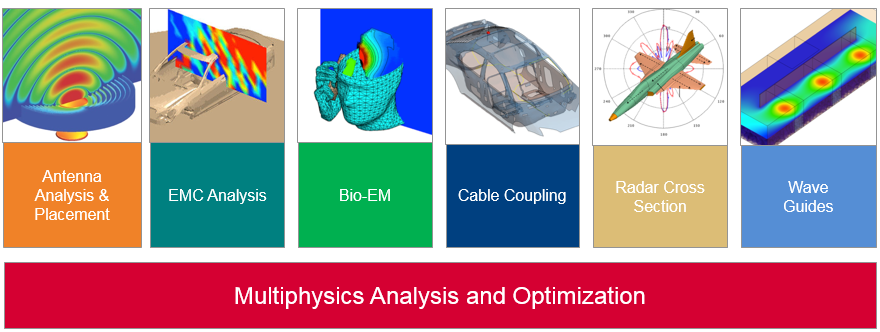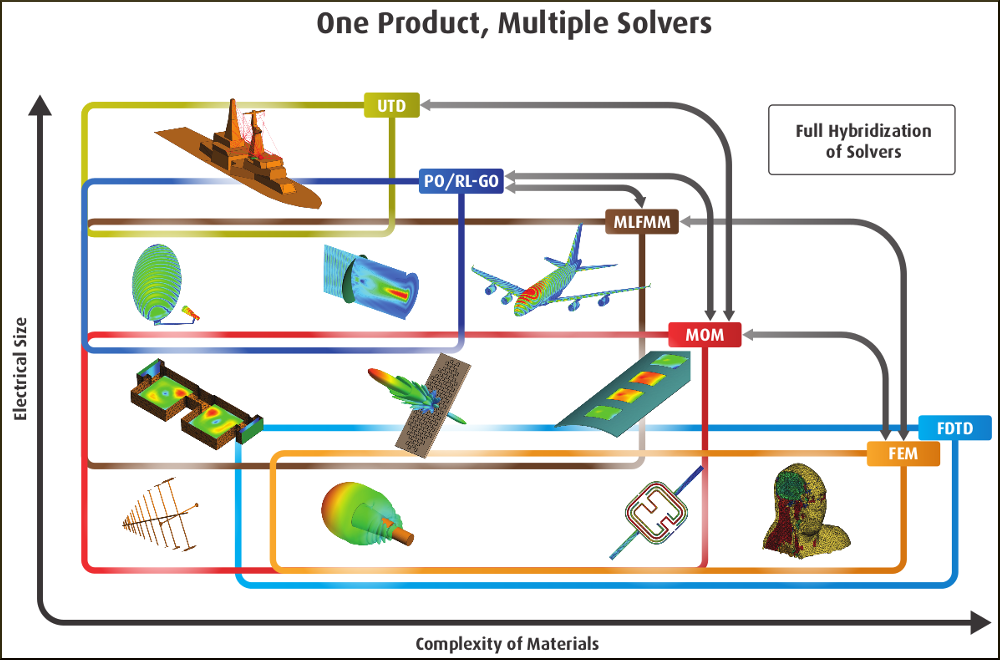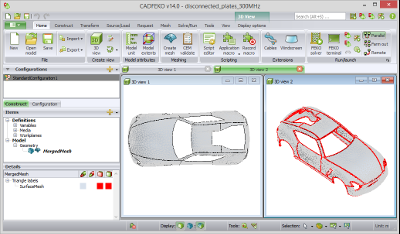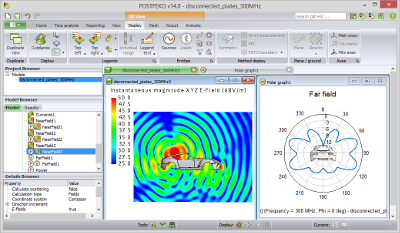
FEKO is the leading electromagnetics solution for high-frequency and scatter analysis and design. The solver provides a comprehensive set of powerful computational methods for electrically small to very large objects and also includes the efficient analysis of thin dielectric sheets, homogeneous or inhomogeneous/anisotropic dielectric bodies and planar stratified media.
FEKO is a suite of applications that besides the solver also includes the modeling and post-processing environments CADFEKO and POSTFEKO, respectively.
FEKO is well integrated with optimization algorithms and also links seamlessly with HyperStudy.
FEKO is currently delivered in a self-contained package. Detailed documentation can be found inside the FEKO installation Start menu > All Programs > Altair HyperWorks 2017 > FEKO > Help > FEKO Help.
FEKO is a powerful 3D simulation package intended for the analysis of a wide range of electromagnetic radiation and scattering problems. Applications include antenna design, antenna placement, microstrip antennas and circuits, dielectric media, scattering analysis, electromagnetic compatibility studies including cable harness modeling and many more. The solver provides a comprehensive set of powerful computational methods for electrically small to very large objects and also includes the efficient analysis of thin dielectric sheets, homogeneous or inhomogeneous/anisotropic dielectric bodies and planar stratified media.

Solution Techniques
| • | Method of Moments (MoM): The MoM is a full wave solution of Maxwell’s integral equations in the frequency domain. FEKO’s MoM implementation is comprehensive for wires, surfaces, dielectric bodies (both volume and surface formulations) and includes advanced features like higher order basis functions on curvilinear meshes. |
| • | MultiLevel Fast Multipole Method (MLFMM): The MLFMM is an alternative formulation of the technology behind the MoM and is applicable to much larger structures than the MoM, making full-wave current based solutions of electrically large structures a possibility. |
| • | Finite Element Method (FEM): The FEM is a field discretization method based on tetrahedral volume meshes. The FEM is applicable to the modeling of inhomogeneous dielectric bodies. |
| • | Uniform Theory of Diffraction (UTD): UTD is an asymptotic high frequency numerical method. It is applicable to electrically extremely large structures with flat polygonal plates (for example the analysis of ships at radar frequencies). It is not well suited to the analysis of complex objects with curved surfaces (for example, automobiles). |
| • | Physical Optics (PO): PO is an asymptotic high frequency numerical method based on currents. |
| • | Large Element Physical Optics (LE-PO): Large element PO is an extension of PO with electrically large mesh elements and the inclusion of a phase term in the basis functions. |
| • | Ray Launching Geometrical Optics (RL-GO): RL-GO is a ray-based method intended for the consideration of electrically large dielectric and perfect electrically conducting structures in applications like the analysis of lens antennas and radomes. |
| • | Finite Difference Time Domain (FDTD): FDTD is a volume meshing technique set in the time domain. It is well suited to modeling inhomogeneous materials and to calculate wide-band frequency domain results. |
| • | Hybridization of methods: FEKO’s unique hybridization of the above mentioned solution techniques within a single model allows the strengths of different solution methods to be combined, resulting in reduced simulation time and memory requirements. |
Applications
| • | Antennas: Horns, microstrip patches, wire antennas, reflector antennas, conformal antennas, broadband antennas, arrays |
| • | Antenna placement: Antenna radiation patterns, radiation hazard zones with an antenna placed on a large structure, for example ship, aircraft, armored car |
| • | Electromagnetic compatibility (EMC): Diverse EMC problems including shielding effectiveness of an enclosure, cable coupling analysis in complex environments, for example wiring in a car, radiation hazard analysis |
| • | Bio-electromagnetics: Homogeneous or non-homogeneous bodies, specific absorption rate (SAR) extraction |
| • | RF components: Waveguide structures, for example filter, slotted antennas, directional couplers |
| • | 3D electromagnetic circuits: Microstrip filters, couplers, inductors |
| • | Radomes: Multiple dielectric layers in a large structure, frequency selective surfaces (FSS) |
| • | Scattering problems: Radar cross section (RCS) analysis of large and small structures |

The FEKO Suite
The FEKO Suite consist of its graphical user interface (GUI) components (CADFEKO and POSTFEKO) and the solver. The GUI’s interface makes use of an intuitive ribbon interface and is easy to learn and use.

|
CADFEKO allows CAD and mesh creation. The user specifies the calculation request and solution method. Application automation allows performing tasks using a script
|
|
|

|
POSTFEKO allows visualization of results obtained from the FEKO solver. Results are displayed on 2D graphs or in combination with the geometry in the 3D view. A powerful application programming interface allows automated post-processing of results. Reports are created quickly and easily using the automatic report generation features.
|
Help
Help for Altair FEKO is split up into multiple documents.
Consult the FEKO Getting Started Guide for walk-through tutorials regarding the use of CADFEKO, POSTFEKO and the FEKO solver.
Consult the FEKO Quick Tips for highlights of the essential information for the CADFEKO and POSTFEKO environments.
Consult the FEKO Examples Guide for typical applications using the CADFEKO, POSTFEKO and the FEKO solver.
Consult the FEKO User Manual for help with the FEKO environment, concepts, application automation and specific help for each feature within FEKO.










